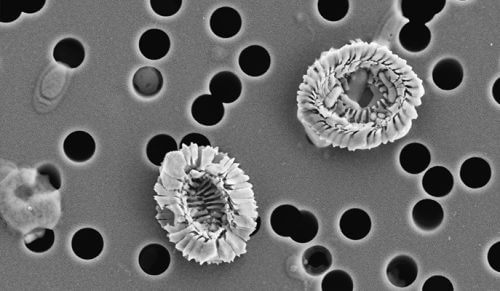Weizmann Institute of Science scientists have discovered that particles of dead algae may be released into the atmosphere, encourage the formation of clouds and divert the sun's radiation from the earth

Does the death of unicellular algae in the ocean lead to an increase in sales of beach umbrellas? The scientists of the Weizmann Institute of Science discovered that when algae (phytoplankton) die as a result of a viral infection, their remains are released into the atmosphere at an increased rate and can lead to a change in the properties of the clouds and a reduction in the sun's glare. in a study which Recently publishedin the scientific journal iScience, the scientists claim that this phenomenon may be a factor influencing the state of the Earth's atmosphere.
Prof. Ilan Koren, Dr. Miri Trinik and Prof. Yanon Rodich from the Department of Earth and Planetary Sciences, and Prof. Assaf Verdi From the Department of Plant and Environmental Sciences, a species of phytoplankton called Emiliania huxleyi. This species is responsible for large-scale blooms that spread rapidly on the surface of the water and disappear quickly, after a few weeks. In a previous study, the researchers showed that the bloom disappears due to the impact of a virus unique to these algae, which spreads rapidly with the help of the wind regime over the ocean. In the current study, the group sought to examine whether the algae - or what remains of them after the viral attack - is also carried by the wind.
the sex Emiliania huxleyi Belongs to the group of coccolithophores - phytoplankton covered with lace-like calcium carbonate shells. When the plankton cells die following a viral infection, many shells sink to the bottom of the ocean and are an important component of the carbon cycle. However, the researchers hypothesized that some of their remains are emitted into the atmosphere alongside salt and other particles, which together constitute sea spray aerosols. These particles are emitted into the atmosphere following the bursting of bubbles that form on the surface of the water. Upon reaching the atmosphere, the aerosols reflect light and move the sun's radiation away from the face of the earth; They also produce nuclei around which cloud droplets can condense.
Particles of materials, such as calcium carbonate, may form a substrate for chemical reactions to occur in the atmosphere, and they may contribute significantly to the amount of radiation returned to space, since they reflect light and reduce the flux of solar radiation absorbed by the sea."

From the right: Prof. Assaf Vardi, Dr. Miri Trinik and Prof. Ilan Koren. Drop in the ocean
To understand how phytoplankton contribute to this process, the first step was to grow them in the laboratory. Dr. Trinick and his team grew the tiny algae in large tanks of seawater, and infected them with the virus. Later, while bubbling the water, the researchers filtered the air above the tank to capture the emitted particles and study them. The researchers found that the flux of phytoplankton particles emitted from the infected samples was much stronger than the flux from the healthy algae. In addition, in the glued cases, the particles were significantly larger. Instead of particles up to a micron in size, they found phytoplankton remains up to four microns in size - probably due to the low specific density of the shells which allows them to fly easily. Says Prof. Verdi: "Some of them look like parachutes or hollow ellipses; They have complex structures made of calcium carbonate with large internal spaces which contribute to the duration of your stay in the atmosphere." The team calculated that the rate of deposition of these particles may be 25 times slower than denser sea salt particles found in aerosols.
During a research trip to the fjords of Norway last summer, the scientists collected water samples in huge bags, with the aim of monitoring not only the organisms living in the water, but also the aerosols they produce during the development of coccolithophore blooms and the dynamics of virus infection. The researchers plan to use these findings to determine the nature of the natural cycles in the atmosphere of substances derived from phytoplankton. Since phytoplankton blooms tend to be denser near the coast, the researchers believe that the atmospheric effects of these blooms will be more felt in these areas.
"Particles of materials, such as calcium carbonate, may form a substrate for chemical reactions to occur in the atmosphere, and they may contribute significantly to the amount of radiation returned to space, since they reflect light and reduce the flux of solar radiation absorbed by the sea," emphasizes Prof. Koren. "Although this research focused on one species and its virus, in a broader context we are learning that the state of the atmosphere depends to a large extent on the daily interactions in the ocean between tiny creatures, viruses and bacteria," says Dr. Trinik.

2 תגובות
interesting and important,
It's just that Leaz's guarantee causes unnecessary errors,
Thus, for example, it is written: ……" Sea spray aerosols "…..
"Aerosols" in Hebrew means sprays,
Hence the Hebrew translation reads: sprays of sprays...
I'm sure if that's what the writers intended,
Therefore, once again, it is appropriate to write in clean Hebrew
And so to avoid errors...
Sounds like an interesting direction for climate engineering.
Here is the "old" way to do it:
https://www.ted.com/talks/david_keith_s_surprising_ideas_on_climate_change/transcript?language=he